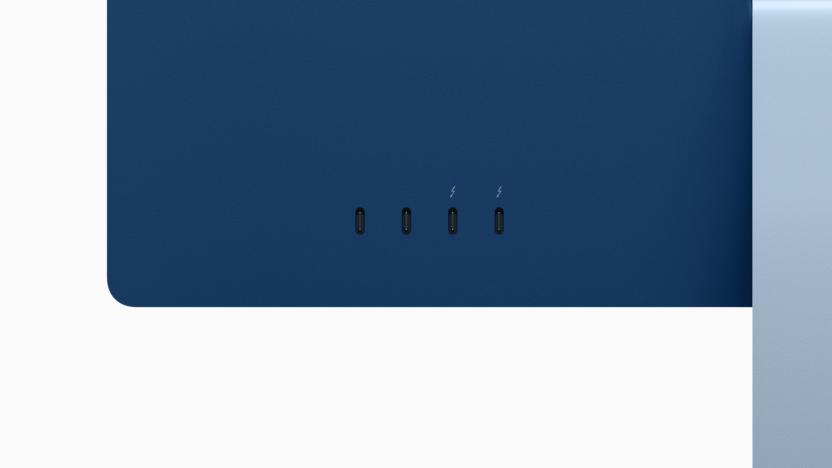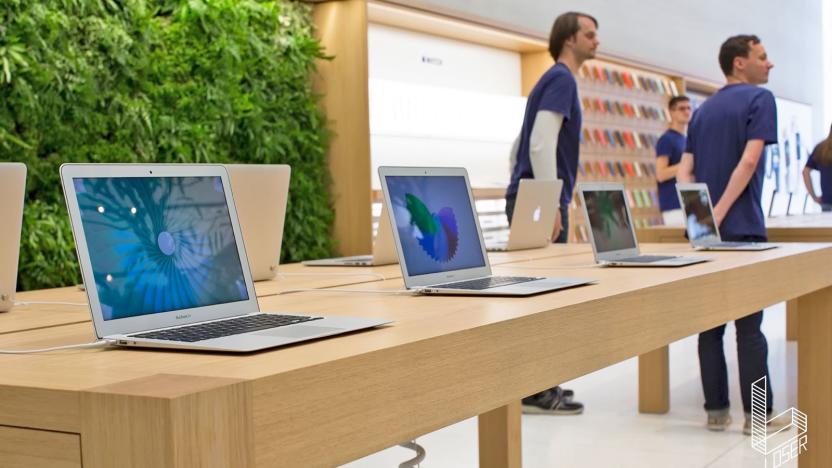dongles
Latest

The new iMac's paltry port selection doesn't bode well for the next MacBook Pro
Apple's new iMac has far fewer ports than the model it replaced, and that could be a bad sign for the next MacBook Pro.

Apple's iPad and Mac event: By the numbers
For the second time in as many months, Apple's executive leadership took to the stage to reveal the company's latest luxury computing products. This time around we saw a new iPad Pro with a fancy magnetic stylus, a Retina-enabled MacBook Air (made entirely of recycled aluminum), a new Mac Mini, and $9 headphone dongles to make the tablet you just dropped a grand on minimally functional in polite society.

2016 was a hard year to be an Apple fan
Tim Cook and the rest of Apple's leadership will probably not look back fondly on 2016. iPhone sales declined for the first time, and Apple's profits followed suit. There are still bright spots, like the company's growing services business, and the company is still making insane amounts of money. Even so, the stalled growth has to be concerning to both the company and its investors. Don't get me wrong, I'm not here to pity Apple. I'm here to commiserate with its fans, the ones who Apple shafted this year. Particularly those of us who waited all year long for a substantial update to the Mac lineup only to be offered a pair of intriguing but compromised new laptops. Or those of us who bought an iPhone 7 and can't use the headphones included with it in our new MacBook Pro, or even those of us trying to figure out which iPad to buy. Across the board, Apple has confusing product lineups with weird and unnecessary compromises. And if you believe the wailing of aggrieved fans across the internet, it seems like plenty of loyal Apple supporters might be contemplating life outside the company's ecosystem. How did we get here?

These $79 dongles will add more ports to Apple's new MacBook
If you've already got your heart set on Apple's new ultrathin MacBook, be sure to set aside $79 for one of these dongles if you want all of the ports you're used to. The new MacBook only includes a headphone jack and a new USB Type-C port, which handles both charging and accessory connectivity, making additional dongles and cables pretty much a necessity. Apple's starting out by offering two A/V-oriented options, which give you either a VGA or HDMI port, as well as a standard USB 3.0 jack and an additional USB Type-C port. Sure, they're expensive, but that's not unusual for Apple's accessories. The good thing about USB Type-C, though, is that it's a completely open standard, so we'll eventually see plenty of cheaper cables and dongles from other companies. But if you want a good deal, you'll probably have to wait until more computers start offering the new USB port.

Why Chromecast may be cool after all
Today, in the TUAW backchannels, we've been discussing Chromecast, Google's sub-$40 streaming dongle for television sets. I like the idea and will probably buy one. If I'm understanding the early publicity correctly, Google has two really strong use cases, but I don't think it's any kind of "competitor" to Apple TV. It's another thing entirely. The real draw for Apple TV isn't mirroring. Sure it mirrors, and sure you can stream data out to it, but you do so with a lot of DRM issues -- with the motion picture and recording industries hovering over your shoulder and making sure you behave. (That's probably a big reason why Google isn't open-sourcing their SDK.) No, the reason people use Apple TV is the content. The draw is Netflix. The draw is Apple special events. The draw is music and slideshows. The draw is any of the other subscription services that let people like Dave Caolo watch baseball. You don't have to bring your phone to ship over compelling material, you just sit on your couch and watch. The Chromecast supports a few services pushed from mobile devices now, like Netflix (although the free ride is over already). Over time, more apps will appear, and one thing they'll all have in common is the device-to-dongle WiFi transmission. Chromecast does not provide a native interface the way the Apple TV does. While content streaming makes sense for some things -- presentations, sharing photos, etc. -- it's not always the best for high bandwidth TV shows and movies. That's why Apple TV comes with an Ethernet port and onboard services that let you catch up without having to mess around with your cell phone or tablet. Admittedly, some of the best things about AirPlay involve game playing, but in my experience -- and that of the devs I consulted with -- it's an extremely minor part of the marketplace, at least at this time. (Ask me again in the fall, when we start to see some of those custom controllers working with phones and iPads.) So where do I expect Chromecast to succeed? For travel -- both business and personal. First, I think it's just dandy for anyone who has business meetings. It is a small, inexpensive dongle without a lot of cords or overheads -- besides the power cords never shown in the promo photos. Still, it will be a mostly trivial affair to pull out your Android or iOS phone and get to presenting, especially with business-supplied Wi-Fi (or, in a pinch, with your own pocket router). I think that's a ridiculously strong and appropriate use of the system. [Note that not all business or enterprise WiFi networks are particularly Apple TV-friendly, depending on their security and routing configurations. It's yet to be seen if Chromecast will be subject to the same networking hurdles, but in the meantime bringing your own router or a 4G hotspot when working with either technology is a good safety net, as is an old-fashioned VGA or HDMI adapter. –Ed.] Second, for low-bandwidth (!) movies and TV shows and music, say when visiting a hotel and watching content from your phone or tablet? I can't see how that's going to be a bad thing at all. (Assuming the hotel offers an HDMI input on its TVs, of course.) I know I'm going way out on a limb here, but I could really see Apple following suit on this, offering an Apple TV 2 Go dongle. The idea of extending AirPlay to a dongle? I just really love that concept. I'm not sure how good or bad Chromecast will be, but I get why Google wants to go there.

Elgato outs smaller EyeTV Mobile for iPhones and iPads, EyeTV Micro for Android
It was at the last IFA we got some time with Elgato's EyeTV Mobile for the iPad, and this year they're at it again with a redesigned iDongle and a brand new model for Android gear. The smaller EyeTV Mobile will have you watching DVB-T broadcasts on your iPhone 4S or iPad (2 or new), while the EyeTV Micro swaps Apple's dock connector for, you guessed it, microUSB. Not all Android devices support the Micro -- you'll need a dual-core CPU, Neon support and at least the 4.0.3 build of ICS. That said, the Micro's a generous little chap, as you can use the included USB cable to hook it up to your PC or Mac and get your TV fix on bigger screens, too. Both peripherals can be used with myriad aerials to meet your reception needs, provided you're in Europe, of course. The Mobile and Micro will be available in September for £89.95 and £54.95 (around $143 and $87), respectively, and we hope to see one on the show floor before IFA 2012 is done, so stay tuned.

Ooma Telo and Telo Air wireless adapter hands-on
Remember the Ooma Telo? It suffered the same fate as most home VoIP adapters: a lifetime chained to the home or office router, bound forever by a freedom-crushing Ethernet cable. But no. No more. The benevolent engineers at Ooma have decided to set the Telo free. Hello, Ooma Telo Air Wireless Adapter -- you're about to put VoIP in our kitchen. Ooma's Voice over IP service and the Telo adapter itself are hardly new, but we couldn't resist giving the outfit's new VOIP liberating dongle a try. Read on for more. %Gallery-133124%

Griffin's Beacon Universal Remote Control System brings dongle-free control to your smartphone
Ditch those dongles and throw out those cases, the next level of smartphone-as-universal-remote technology is here. Beacon Universal Remote Control System from Griffin Technology and Dijits turns your iPhone and other iOS devices into omnipotent remote controls, by converting Bluetooth signals into infrared commands that your stereo, TV, and other devices can recognize. Paired with Dijit's Universal Remote App, Beacon, which looks something akin to a game show buzzer, converts your touchscreen to a remote, making all the added cases, dongles, and even cords unnecessary -- it can run up to two months on four AA batteries. Beacon hits the market in May 2011 for $79.99, but if you're lucky enough to be at CES this week, you can check out a demo at Griffin's booth.

Jabra announces iPod Bluetooth adapter
Since Apple's still showing no sign of caving into consumer demand and releasing a Bluetooth-equipped iPod (even a proprietary solution would be a good start -- anything to get rid of that annoying white cord), more and more manufacturers are looking to fill the void with their own workarounds, and now headset giant Jabra has announced plans to throw its own hat into the ring as well. Jabra's "hat" will come in the form of a dock connector-compatible adapter called the A125s, which will work with both the video and nano versions of the iPod, and promises 10 hours of playback or 250 hours of standby time before recharging becomes an issue. Unfortunately for exercise enthusiasts, these won't work at the same time as your Nike+iPod kit, so runners won't be able to cut the cord unless Nike releases its own pair of headphones. You can expect this adapter -- which will join the likes of the D.Muse, icombi, and naviPlay -- to retail for around $75 once it hits stores sometime this August.





